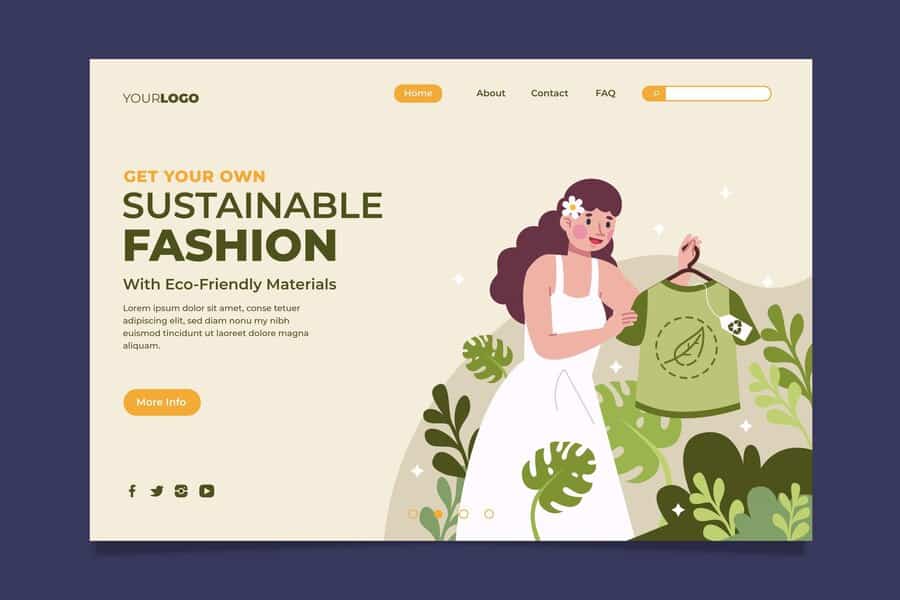
Fast Fashion vs Sustainable Fashion: A Comparison
Are you aware of the environmental impact of the clothes you wear? Have you ever considered the ethical implications of the fashion industry?
Fast fashion and sustainable fashion are two contrasting approaches to clothing production that have a far-reaching effect on our planet and society.
But how different are they really?
Key Takeaways
- Fast fashion and sustainable fashion are two opposing approaches to clothing production.
- Fast fashion prioritizes low-cost, mass production, and quick turnover, while sustainable fashion focuses on ethical production and environmental responsibility.
- Fast fashion contributes to environmental issues such as pollution, waste, and climate change, while sustainable fashion strives for longevity and reduced environmental impact.
- The fashion industry is shifting towards sustainability, with the emergence of sustainable fashion brands and increasing consumer demand for ethical clothing options.
- Choosing sustainable fashion can make a positive difference in the world, helping to protect the environment and support fair labor practices.
Understanding Fast Fashion
Fast fashion has revolutionized the fashion industry, providing consumers with affordable, trendy clothing at a rapid pace.
However, behind the scenes, the production and consumption of fast fashion have raised concerns about its impact on ethics, sustainability, and the environment.
In this section, we will explore the concept of fast fashion, its social and environmental implications, and its comparison to slow fashion alternatives.
The Rise of Fast Fashion
Fast fashion brands such as Zara, H&M, and Forever 21 have gained popularity for their ability to quickly replicate runway trends and make them accessible to the masses.
These brands utilize global supply chains and prioritize speed and efficiency in their production processes.
This allows them to bring new styles to market in a matter of weeks, feeding the demand for constantly changing fashion.
Fast fashion brands focus on producing large quantities of garments at low costs. By cutting corners in production and sourcing cheaper materials, they are able to offer fashion at incredibly affordable prices.
This low-cost approach has made fast fashion accessible to a wide range of consumers.
Social and Environmental Implications
While fast fashion may seem like a win for affordability and accessibility, it comes with significant social and environmental consequences.
Fast fashion brands often outsource production to countries with lower labor costs, where workers may experience poor working conditions, low wages, and even exploitation.
This raises concerns about the ethics of fast fashion and the need for better labor practices in the industry.
In terms of the environment, fast fashion’s rapid production and disposable nature contribute to resource depletion and waste generation.
The rise of ultra-fast fashion, fueled by the demand for even faster and cheaper clothing, exacerbates these issues.
This constant cycle of buying and discarding garments leads to a significant amount of textile waste, adding to the already mounting global waste problem.
Comparison to Slow Fashion
To understand the impact of fast fashion, it is essential to compare it to its counterpart, slow fashion. Slow fashion brands prioritize sustainability, ethical production, and longevity of garments.
They focus on quality over quantity, using sustainable materials and offering timeless designs that are meant to last.
While slow fashion may come at a higher price point, it promotes responsible consumption and values the craftsmanship and artistry of the clothing industry.
Below is a comparison between fast fashion and slow fashion:
Fast Fashion |
Slow Fashion |
|---|---|
| Mass production | Small-scale production |
| Low cost | Higher cost |
| Disposable nature | Long-lasting garments |
| Exploitative labor practices | Ethical production |
| Environmental impact | Sustainable materials and practices |
By understanding the differences between fast fashion and slow fashion, consumers can make more informed choices about the clothing they purchase and support brands that align with their values.
Exploring Sustainable Fashion
When it comes to fashion, there is a growing movement toward sustainability, which aims to address the negative environmental and social impacts of the industry.
Sustainable fashion goes beyond simply producing clothes; it encompasses the entire lifecycle of a garment, from design and production to distribution and disposal.
The goal is to create a more responsible and ethical fashion industry that prioritizes the well-being of people and the planet.
So, how does sustainable fashion differ from fast fashion? While fast fashion prioritizes speed and low cost, sustainable fashion takes a more holistic and long-term approach.
Let’s explore the various aspects that make sustainable fashion different from fast fashion.
The Fashion Industry Landscape
In the world of fashion, there are two main models: fast fashion and slow fashion.
Fast fashion refers to the rapid production of trendy and affordable clothing, often associated with fast-changing trends and a high turnover of styles.
On the other hand, slow fashion, which is synonymous with sustainable fashion, focuses on timeless designs, high-quality materials, and ethical production practices.
Sustainable fashion encompasses not only the environmental aspects but also considers the social and economic impact of the fashion industry.
It aims to promote fair wages, safe working conditions, and respectful treatment of workers throughout the supply chain.
Additionally, sustainable fashion advocates for transparency and responsible sourcing of materials, reducing waste, and minimizing pollution.
The Key Differences
When comparing fast fashion and sustainable fashion, several key differences emerge:
- Production and Consumption: Fast fashion promotes mass production and consumerism, encouraging frequent purchases of cheaply made garments. Sustainable fashion, on the other hand, advocates for reduced production and an emphasis on quality, durability, and timeless designs.
- Environmental Impact: Fast fashion has a significant environmental footprint due to the use of non-sustainable materials, excessive water consumption, and the generation of large amounts of waste. Unsustainable fashion seeks to minimize environmental harm by using organic and recycled materials, implementing eco-friendly production processes, and promoting circularity through recycling and upcycling.
- Social Responsibility: Fast fashion has faced criticism for exploitative labor practices, including low wages, unsafe working conditions, and unethical treatment of workers. In contrast, sustainable fashion prioritizes fair wages, worker well-being, and ensuring ethical sourcing of materials.
The Future of Fashion
As consumers become more conscious of the impact of their choices, demand for sustainable fashion continues to rise.
Many fashion brands are now incorporating sustainable practices, materials, and production techniques to meet this demand.
The fashion industry is undergoing a transformation, with influential designers, retailers, and consumers advocating for a shift toward sustainability.
Sustainable Fashion |
Fast Fashion |
|---|---|
| Prioritizes ethical production and fair labor practices | Frequently relies on exploitative labor in low-cost countries |
| Uses sustainable materials and promotes recycling | Often relies on non-sustainable materials and generates high amounts of waste |
| Emphasizes durability and timeless designs | Focuses on quick production and trendy, disposable styles |
By continuing to support sustainable fashion and making conscious choices as consumers, we can contribute to a more ethical and environmentally friendly fashion industry.
Together, we have the power to shape a future where fashion is not only stylish but also sustainable.
The Environmental Impact
In today’s fast-paced fashion industry, the environmental impact of fast fashion cannot be ignored. From climate change to pollution, the detrimental effects of fast fashion on our planet are significant and far-reaching.
One of the key contributors to environmental degradation is the waste generated by fast fashion.
With the rise of cheap, disposable clothing, consumers often discard garments after only a few uses.
This leads to overflowing landfills and an increase in greenhouse gas emissions as these garments decompose.
Water usage is another major concern. The production of fast fashion requires vast amounts of water, both for growing cotton and for dyeing textiles.
This puts a strain on water resources, leading to water scarcity in many regions.
Additionally, the carbon footprint associated with fast fashion is substantial.
The extraction of raw materials, transportation of goods, and manufacturing processes all contribute to carbon emissions, exacerbating climate change.
To illustrate the environmental impact of fast fashion, consider the following statistics:
Environmental Issue |
Fast Fashion Impact |
|---|---|
| Climate Change | Fast fashion is a significant contributor to greenhouse gas emissions, accounting for approximately 10% of global carbon emissions. |
| Pollution | The production of synthetic fibers, such as polyester, releases microplastics into our oceans. These microplastics are ingested by marine life, causing harm to ecosystems. |
| Water Usage | It takes an estimated 2,700 liters of water to produce a single cotton t-shirt, including the cultivation of cotton and textile processing. |
| Waste Generation | The fashion industry produces over 92 million tons of textile waste annually, with the majority ending up in landfills. |
It is clear that fast fashion’s impact on the environment is substantial and unsustainable. To mitigate these effects, a shift towards sustainable fashion practices is vital.
By embracing ethical production methods, promoting garment longevity, and encouraging conscious consumer choices, we can work towards a more environmentally friendly fashion industry.
Ethical Considerations
When it comes to fast fashion, ethical concerns loom large. The fashion industry’s reliance on sweatshops and exploitative labor practices has raised questions about the ethics of fast fashion.
Workers’ rights are often compromised, with poor working conditions, low wages, and long hours becoming the norm.
However, there is also a growing movement within the industry to address these ethical challenges.
Brands are starting to acknowledge the need for sustainable and socially responsible practices.
They are making efforts to improve working conditions, provide fair wages, and ensure transparency throughout the supply chain.
“Fast fashion can be a catalyst for positive change in the industry. By prioritizing ethical practices and investing in sustainable materials, brands have the power to transform the way fashion is produced and consumed.”
While fast fashion has traditionally been associated with negative social impacts, there is potential for it to be more than just a social issue.
By adopting eco-friendly production methods, incorporating sustainable materials, and operating with a commitment to workers’ rights, fast fashion can become a force for good.
Can Fast Fashion and Sustainability be Stitched Together?
The question of whether fast fashion and sustainability can be stitched together is not a simple one. It requires a shift in mindset and a collective effort from both brands and consumers.
However, there are promising initiatives underway.
Some brands are exploring circular economy models, where products are designed to be recycled or repurposed at the end of their lifecycle.
Others are investing in renewable energy sources and reducing their carbon footprint. These are important steps towards a more sustainable and ethical fashion industry.
- Investing in sustainable and organic materials
- Encouraging fair trade and worker empowerment
- Practicing transparency in the supply chain
- Reducing waste and promoting circular economy
By embracing these strategies, fast fashion brands can contribute to a more eco-friendly future. It requires a commitment to change and a willingness to prioritize sustainability alongside profitability.
While challenges remain, the possibility of fast fashion becoming more ethical and environmentally friendly is within reach.
It requires conscious choices, industry-wide collaboration, and consumer demand for sustainable practices.
By asking tough questions and demanding change, we can shape a fashion industry that is not only stylish but also responsible.
Shifting the Fashion Industry
Fast fashion has had a tremendous impact on the fashion industry, revolutionizing the way clothes are produced, consumed, and discarded.
To understand how fast fashion has transformed the industry, let’s take a closer look at how it started and how it works.
The Origins of Fast Fashion
Fast fashion first emerged in the 1980s and gained momentum in the 1990s with the rise of brands like Zara, H&M, and Forever 21.
These brands pioneered a new business model that focused on accelerating the production and distribution of trendy, affordable clothing.
The fashion industry was traditionally characterized by seasonal collections and longer lead times, but fast fashion disrupted this model by introducing rapid production cycles, with new styles hitting stores as frequently as every two weeks.
How Fast Fashion Works
Fast fashion brands prioritize speed and efficiency in every aspect of their operations.
They closely monitor fashion trends, gather customer feedback, and quickly transform those insights into new designs for mass production.
These designs are manufactured at a rapid pace, often in countries with lower labor costs.
Fast fashion brands employ strategies like outsourcing manufacturing and utilizing sweatshop labor to keep production costs as low as possible.
Once the garments are produced, they are swiftly transported to stores and online platforms, where they are marketed and sold at highly competitive prices.
Constant markdowns and promotions further encourage consumers to make frequent purchases.
The sequel follows the rise of online shopping, with fast fashion brands leveraging e-commerce platforms to reach a wider audience and increase their sales. This has further accelerated the pace of fast fashion and its impact on the environment.
The Impact on the Fashion Industry
Fast fashion has revolutionized the fashion industry by democratizing fashion and making trendy clothing accessible to a larger consumer base.
However, its rapid production cycles and unsustainable practices have raised concerns and prompted a call for change.
Fast fashion’s emphasis on disposable, low-quality garments has contributed to a culture of overconsumption and excessive waste.
In fact, the fashion industry is now one of the largest polluters globally, producing countless tons of textile waste and contributing to pollution, water scarcity, and climate change.
Consumers and industry experts are increasingly pushing for sustainable alternatives to fast fashion.
They are demanding greater transparency, ethical manufacturing practices, and environmentally friendly materials.
As a result, sustainable fashion brands are emerging, offering high-quality, durable clothing that is produced using eco-friendly practices.
By embracing sustainability and supporting these brands, fashion industry stakeholders can help shift the industry towards a more ethical and environmentally conscious future.
From consumers making mindful purchasing choices to brands adopting sustainable practices, collaboration is key in transforming the fashion industry.
Conclusion:
Fast Fashion vs Sustainable Fashion: A Comparison
In conclusion, the comparison between fast fashion and sustainable fashion highlights the urgent need for change in the fashion industry.
Fast fashion, with its rapid production, low cost, and disposable nature, has detrimental effects on the environment, ethics, and overall sustainability.
However, sustainable fashion offers a more responsible and conscious approach to production and consumption.
Emphasizing the importance of sustainable fashion, numerous brands have emerged that prioritize ethical production, environmental responsibility, and long-lasting garments.
Some noteworthy sustainable fast fashion brands include Patagonia, EILEEN FISHER, and Everlane.
These brands prioritize transparency, fair trade practices, and the use of eco-friendly materials.
While it is unlikely that fast fashion will completely end, it is possible for the fashion industry to transition towards a more sustainable future.
By supporting sustainable fast fashion brands and demanding greater transparency from fashion companies, consumers can contribute to the transformation of the industry.
Through collective efforts, we can reduce the environmental impact and ethical concerns associated with fashion, promoting a more sustainable and responsible fashion industry for future generations.
FAQ
What is the difference between fast fashion and slow fashion?
Fast fashion refers to the rapid production and distribution of inexpensive clothing, often resulting in low-quality garments that are quickly discarded.
Slow fashion, on the other hand, focuses on sustainable production methods, ethical labor practices, and the creation of durable, timeless pieces.
Does fast fashion contribute to climate change?
Yes, fast fashion significantly contributes to climate change. The production of fast fashion garments involves high levels of greenhouse gas emissions, water usage, and waste generation.
Additionally, the transportation of these garments globally further adds to their carbon footprint.
Can fast fashion be ethical?
Fast fashion is often associated with unethical practices, such as the use of sweatshops and exploitative labor conditions.
However, efforts are being made by some brands to improve their ethical standards. It is important to research and support brands that prioritize ethical production methods.
Why did fast fashion start?
Fast fashion emerged in response to consumer demands for trendy, inexpensive clothing. Brands began accelerating the production process, reducing costs, and offering frequent collections to keep up with rapidly changing fashion trends.
How has fast fashion changed the fashion industry?
Fast fashion has revolutionized the fashion industry by making clothing more accessible and affordable.
However, it has also led to a culture of overconsumption, created environmental and ethical concerns, and put pressure on garment workers in low-wage countries.
Is fast fashion bad for the environment?
Yes, fast fashion has a significant negative impact on the environment.
The industry produces massive amounts of textile waste, utilizes extensive natural resources, contributes to pollution, and increases carbon emissions, all of which harm ecosystems and contribute to climate change.
Can fast fashion and sustainability be stitched together?
While fast fashion and sustainability may seem contradictory, there are efforts being made to make fast fashion more sustainable.
Some brands are adopting eco-friendly materials, implementing ethical production practices, and promoting circular fashion principles to reduce waste.
Will fast fashion ever end?
The fashion industry is gradually shifting towards more sustainable practices, but the complete eradication of fast fashion will require systemic changes.
Consumer awareness, demand for sustainable alternatives, and industry-wide collaboration are crucial factors in driving this change.
Related read:Winter Outfits 2023| Stay Stylish and Warm







